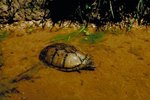
Tortoises are slow to mature and breed. This makes them vulnerable. When humans disrupt this delicate balance of nature, it makes them endangered. Tortoises are one of the most threatened groups of animals on the planet due to a combination of habitat loss, being hunted for food and illegal pet trade.
Spider and Ploughshare
The most endangered tortoises in the world are ploughshare tortoises. They are native to Madagascar, and it is estimated there are approximately 200 to 600 left on the planet. In February 2013, smugglers at a Thailand airport were caught trying to smuggle out 54 of them. This would be approximately 10 percent of the tortoise’s population. Madagascar is also the home to spider tortoises. Not only are they being poached in mass numbers, but due to agricultural harvesting they are losing their habitat at a rate of 1.2 percent per year.
African Spurred and Elongated
The population of African spurred tortoises is declining quickly due to urbanization in places such as Mali and Ethiopia. They’re also food for certain ethnic groups and nomadic tribes. In recent years, their international trade has increased due to an interest in them as pets as well as the body parts that are used for potions in Japan. Throughout Southeast Asia, elongated tortoises are also endangered mainly due to food consumption and a disregard for international conservation laws. They are one of the most common tortoises shipped to Chinese food markets.
Gopher and Desert
The United States is home to two endangered species, and in the southeast Gopher tortoises are an important ecological keystone. They make several burrows for themselves in the ground, and their active or inactive burrows are used by more than 100 other vertebrates and invertebrates including raccoons and snakes. They are threatened due to habitat loss and pet trade. On the West Coast, desert tortoises are threatened by development, mining and poaching. As their name indicates they live in the desert, and they are increasingly run over by the growing use of recreational off-road vehicles.
Forsten’s and Travancore
Forsten’s and Travancore tortoises are forest dwellers and were once thought to be the same species.They are recognized now as two separate tortoises; however they are still sharing the same demise due to mining of the tropical forests and food consumption. Forsten’s tortoises are found only on the Indonesian islands of Sulawesi and Halmahera, while Travancores are found in the mountains of southwest India.
Aldabra Giant and Lonesome George
In June 2012, a giant Pinta Island tortoise named Lonesome George was thought to be the last of his species when he died at the age of 100. However, Yale researchers have discovered DNA from George’s ancestors in 17 tortoises inside a hybrid population on another Galapagos Island. On islands in the Indian Ocean, Aldabra giant tortoises began meeting their demise centuries ago. In the 17th to 19th centuries these giants were a food source for sailors. These sailors also introduced non-native predators such as rats and goats to these islands.
References
- Arkive: Spider Tortoise
- Arkive: Ploughshare Tortoise
- Arkive: African Spurred Tortoise
- Arkive: Elongated Tortoise
- Arkive: Gopher Tortoise
- Arkive: Desert Tortoise
- Arkive: Forsten's Tortoise
- British Chelonia Group: Range Extension of the Travancore Tortoise (Indotestudo Forsteni) and the Cane Turtle (Geoemyda Silvatica) Reptilia: Testudines: Testudinidae and Emydidae, Along the Western Ghats of South India - a Report
- Arkive: Aldabra Giant Tortoise
- National Geographic: Daily News - Lonesome George Not the Last of His Kind, After All?
Resources
Photo Credits
-
Stockbyte/Stockbyte/Getty Images
Writer Bio
Slone Wayking worked as a professional in the veterinary field for 20 years. Though her interest in animal health led to this path, Wayking initially studied creative arts. She has been article writing for more than a year and is currently working towards her degree in multimedia. Her certifications include business writing and basic web design.




